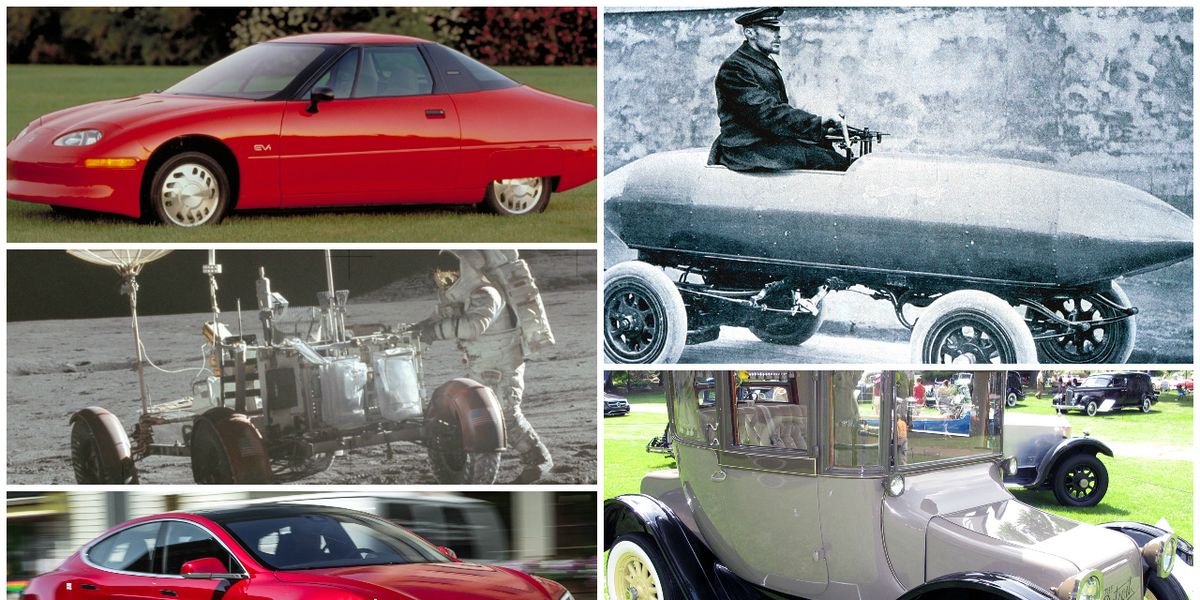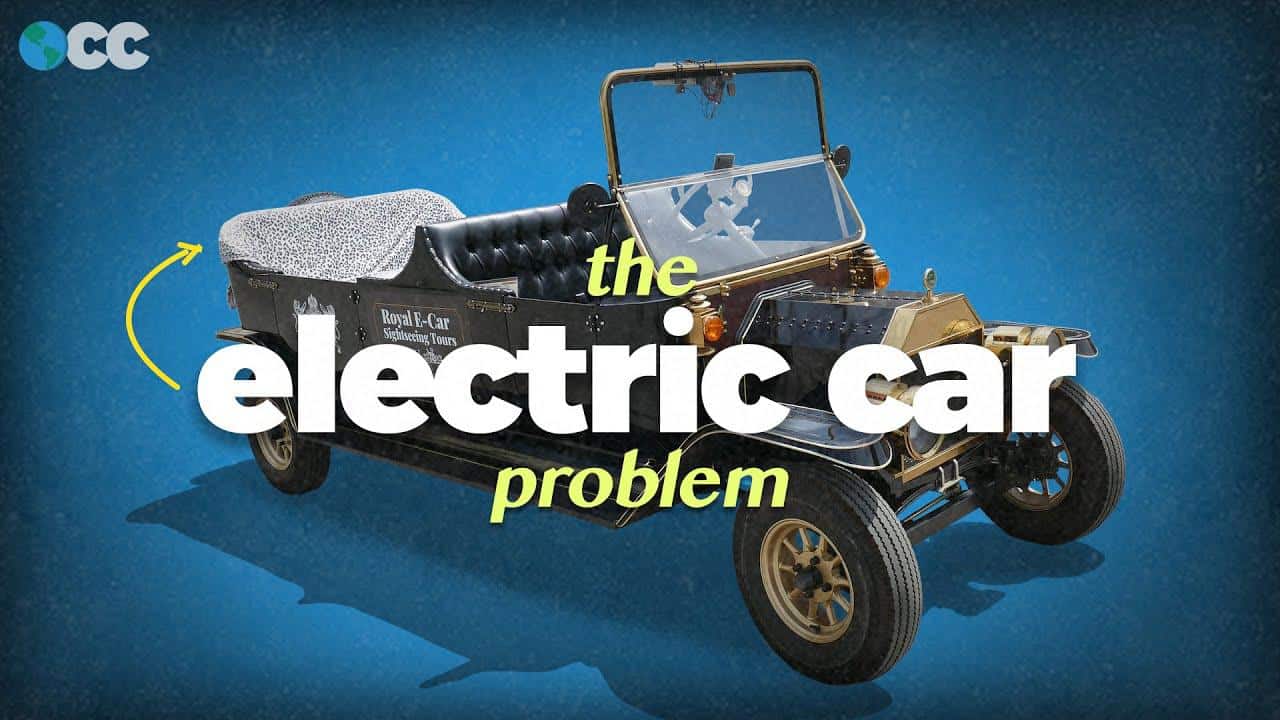5fish
Well-Known Member
- Joined
- Jul 28, 2019
- Messages
- 10,690
- Reaction score
- 4,551
We had electric vehicles have been with us since 1828...

 en.wikipedia.org
.
en.wikipedia.org
.
The invention of the first model electric vehicle is attributed to various people.[7] In 1828, Ányos Jedlik invented an early type of electric motor, and created a small model car powered by his new motor. Between 1832 and 1839, Scottish inventor Robert Anderson also invented a crude electric carriage.[8] In 1835, Professor Sibrandus Stratingh of Groningen, the Netherlands and his assistant Christopher Becker from Germany also created a small-scale electric car, powered by non-rechargeable primary cells.
snip...
The first electric car in the United States was developed in 1890–91 by William Morrison of Des Moines, Iowa; the vehicle was a six-passenger wagon capable of reaching a speed of 23 kilometres per hour (14 mph). It was not until 1895 that consumers began to devote attention to electric vehicles after A.L. Ryker introduced the first electric tricycles to the U.S
Here is another more details look... its is a good brief history of electric cars....

 www.caranddriver.com
www.caranddriver.com
Start in the 1830s, with Scotland’s Robert Anderson, whose motorized carriage was built sometime between 1832 and ’39. Batteries (galvanic cells) were not yet rechargeable, so it was more parlor trick (“Look! No horse nor ox, yet it moves!”) than a transportation device. Another Scot, Robert Davidson of Aberdeen, built a prototype electric locomotive in 1837. A bigger, better version, demonstrated in 1841, could go 1.5 miles at 4 mph towing six tons. Then it needed new batteries. This impressive performance so alarmed railway workers (who saw it as a threat to their jobs tending steam engines) that they destroyed Davidson’s devil machine, which he’d named Galvani. Batteries that could be recharged came along in 1859, making the electric-car idea more viable.
snip...
Electrobat! Is that not a great name? It belongs to the first commercially viable EV effort. Philadelphians Pedro Salom and Henry G. Morris adapted technology from battery-electric street cars and boats and got a patent in 1894. At first very heavy and slow (like a trolley car, with steel “tires” and 1600 pounds of batteries onboard), their Electrobat [at left] evolved to employ pneumatic tires and lighter materials so that, by 1896, their rear-steer carriages used two 1.1-kW motors to move 25 miles at a top speed of 20 mph. Electrobats and another electric by Riker won a series of five-mile sprint races against gasoline Duryea automobiles in 1896.
snip... electric cars held some of the first land speed records....
Electric cars proved their mettle in early motorsports. Belgian Camille Jenatzy, a builder of electric carriages near Paris, engaged in several speed stunts to promote his firm’s engineering acumen, the highlight of which came in the spring of 1899. Driving his racing special, La Jamais Contente (“the Never Satisfied”), he became the first to break the 100-km/h and 60-mph barriers. A pair of direct-drive 25-kW motors, running at 200 volts drawing 124 amps each (about 67 horsepower), propelled the torpedo-shaped machine crafted from a lightweight aluminum alloy called partinium. La Jamais Contente ran on Michelin tires; the French tiremaker adopted a reproduction built in 1994 to serve as a sort of mascot for the company’s Challenge Bibendum series of sustainable mobility rallies from 2004–2014.
snip... I found a German...
Another one-off museum piece is the Egger-Lohner C.2 Phaeton [top right] engineered by 23-year-old Dr. Ferdinand Porsche, whose son would found today’s Porsche company after World War II. The 1898 car’s electric-drive system weighed 286 pounds, made 5 horsepower, and could push the buggy to 22 mph. On spec, it doesn’t look more impressive than Morrison’s 1893 World’s Fair “car,” but it won a 25-mile race for electric vehicles at a Berlin exhibition on September 28, 1899.
snip... electric starters doom electric cars...
Ironically enough, it was an electric motor that became the real enemy of battery-powered cars and helped overcome Clara’s objections: The advent of the electric starter (invented by Charles Kettering at Dayton Engineering, first for the 1912 Cadillac) did away with the hand-crank problem for gas cars once it spread through the industry. Electrics got a bit of a boost during World War I when gasoline prices rose and fuel availability was sometimes spotty, but by the mid-1920s, Detroit Electric’s “new” cars were often constructed on bodies that had been built years earlier and unsold. All the same, it built more than 35,000 vehicles between 1907 and 1939.
snip... The first vehicle on the moon was electric...
Four LRVs were built at a cost of $38 million, an overrun of 100 percent on the original $19 million projection. Driven nine times (three excursions on each of three missions), it was the most exotic “car” ever. First deployed on the Apollo 15 mission in 1971 (as shown here), the LRV used non-rechargeable silver-zinc potassium hydroxide batteries with a stated capacity of 121 amp-hours. Steering at both axles also was by electric motor drawing on the same batteries. Built of aluminum tubes and foldable in the center to stow onboard the Apollo lunar lander, it weighed 460 pounds (in Earth's gravity) without passengers, whose space suits had to be redesigned so they could sit in it.

History of the electric vehicle - Wikipedia
 en.wikipedia.org
en.wikipedia.org
The invention of the first model electric vehicle is attributed to various people.[7] In 1828, Ányos Jedlik invented an early type of electric motor, and created a small model car powered by his new motor. Between 1832 and 1839, Scottish inventor Robert Anderson also invented a crude electric carriage.[8] In 1835, Professor Sibrandus Stratingh of Groningen, the Netherlands and his assistant Christopher Becker from Germany also created a small-scale electric car, powered by non-rechargeable primary cells.
snip...
The first electric car in the United States was developed in 1890–91 by William Morrison of Des Moines, Iowa; the vehicle was a six-passenger wagon capable of reaching a speed of 23 kilometres per hour (14 mph). It was not until 1895 that consumers began to devote attention to electric vehicles after A.L. Ryker introduced the first electric tricycles to the U.S
Here is another more details look... its is a good brief history of electric cars....

The Electric Car’s History Goes Back Further Than You Think
The first electric cars appeared long before the earliest gas autos, and the history of electric cars is littered with innovative takes on four-wheeled transit.
Start in the 1830s, with Scotland’s Robert Anderson, whose motorized carriage was built sometime between 1832 and ’39. Batteries (galvanic cells) were not yet rechargeable, so it was more parlor trick (“Look! No horse nor ox, yet it moves!”) than a transportation device. Another Scot, Robert Davidson of Aberdeen, built a prototype electric locomotive in 1837. A bigger, better version, demonstrated in 1841, could go 1.5 miles at 4 mph towing six tons. Then it needed new batteries. This impressive performance so alarmed railway workers (who saw it as a threat to their jobs tending steam engines) that they destroyed Davidson’s devil machine, which he’d named Galvani. Batteries that could be recharged came along in 1859, making the electric-car idea more viable.
snip...
Electrobat! Is that not a great name? It belongs to the first commercially viable EV effort. Philadelphians Pedro Salom and Henry G. Morris adapted technology from battery-electric street cars and boats and got a patent in 1894. At first very heavy and slow (like a trolley car, with steel “tires” and 1600 pounds of batteries onboard), their Electrobat [at left] evolved to employ pneumatic tires and lighter materials so that, by 1896, their rear-steer carriages used two 1.1-kW motors to move 25 miles at a top speed of 20 mph. Electrobats and another electric by Riker won a series of five-mile sprint races against gasoline Duryea automobiles in 1896.
snip... electric cars held some of the first land speed records....
Electric cars proved their mettle in early motorsports. Belgian Camille Jenatzy, a builder of electric carriages near Paris, engaged in several speed stunts to promote his firm’s engineering acumen, the highlight of which came in the spring of 1899. Driving his racing special, La Jamais Contente (“the Never Satisfied”), he became the first to break the 100-km/h and 60-mph barriers. A pair of direct-drive 25-kW motors, running at 200 volts drawing 124 amps each (about 67 horsepower), propelled the torpedo-shaped machine crafted from a lightweight aluminum alloy called partinium. La Jamais Contente ran on Michelin tires; the French tiremaker adopted a reproduction built in 1994 to serve as a sort of mascot for the company’s Challenge Bibendum series of sustainable mobility rallies from 2004–2014.
snip... I found a German...
Another one-off museum piece is the Egger-Lohner C.2 Phaeton [top right] engineered by 23-year-old Dr. Ferdinand Porsche, whose son would found today’s Porsche company after World War II. The 1898 car’s electric-drive system weighed 286 pounds, made 5 horsepower, and could push the buggy to 22 mph. On spec, it doesn’t look more impressive than Morrison’s 1893 World’s Fair “car,” but it won a 25-mile race for electric vehicles at a Berlin exhibition on September 28, 1899.
snip... electric starters doom electric cars...
Ironically enough, it was an electric motor that became the real enemy of battery-powered cars and helped overcome Clara’s objections: The advent of the electric starter (invented by Charles Kettering at Dayton Engineering, first for the 1912 Cadillac) did away with the hand-crank problem for gas cars once it spread through the industry. Electrics got a bit of a boost during World War I when gasoline prices rose and fuel availability was sometimes spotty, but by the mid-1920s, Detroit Electric’s “new” cars were often constructed on bodies that had been built years earlier and unsold. All the same, it built more than 35,000 vehicles between 1907 and 1939.
snip... The first vehicle on the moon was electric...
Four LRVs were built at a cost of $38 million, an overrun of 100 percent on the original $19 million projection. Driven nine times (three excursions on each of three missions), it was the most exotic “car” ever. First deployed on the Apollo 15 mission in 1971 (as shown here), the LRV used non-rechargeable silver-zinc potassium hydroxide batteries with a stated capacity of 121 amp-hours. Steering at both axles also was by electric motor drawing on the same batteries. Built of aluminum tubes and foldable in the center to stow onboard the Apollo lunar lander, it weighed 460 pounds (in Earth's gravity) without passengers, whose space suits had to be redesigned so they could sit in it.


